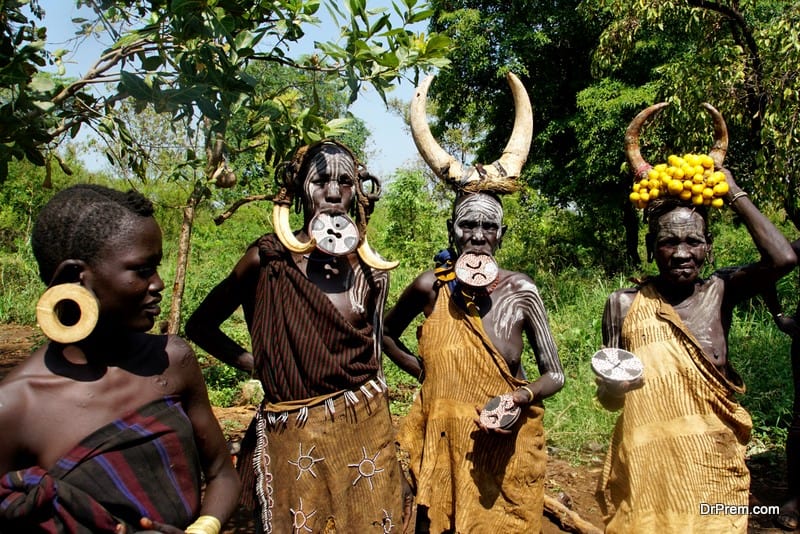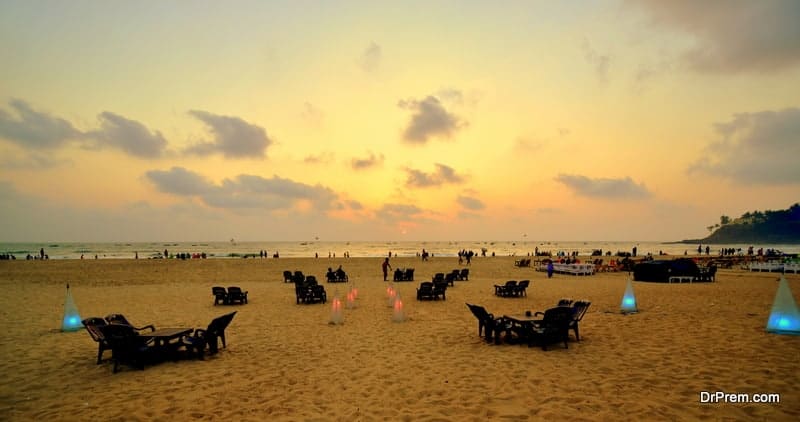After having a wide globetrotting exposure to the primitive tribes around the world including Papua New Guinea, the depths of Amazon and Borneo, I would rate Ethiopia the most colorful tribal belt ever that left me stunned. You would find several tribes there pitted against each other to exercise their might. The Mursi is one of the most fascinating Ethiopian tribal groups where men and women folk are well known for traditional dresses and accessories; especially the women going for stunning lip piercing arts. They call themselves as a Nilotic paternalistic ethnic community living in Ethiopia, and dwell in the Debub Omo Zone of the Southern Nations Nationalities and People’s region.
Appearance
The Mursis have a mind gripping appearance of all the Ethiopian tribes so far as facial display (or rather lip display) is concerned. They adore themselves with decorative lip plates which can be dreadful to think of for an average person. Tall and lean, the Mursi folks have mastered the local martial arts quite proficiently. Men scar their left shoulder to show they have attained the age to marry. Specific to this tribe, both men and women paint their bodies and faces in white.
Women Lip art – Attractive and scary!
At the adolescent age of 15 or 16, the women folk have their lips pierced and a small clay plate is inserted through the lip hole. As the years pass by, larger plates are inserted through the lips making it expand like a piece of rubber. Larger and heavier the clay plate more would be the value of the bride before marriage.
I sucked in my breath seeing for the first time the heavy lip plates and wandered the mammoth potential required to carry such a massive weight loaded onto a sensitive facial area as delicate as a pair of lips. This must be an inhuman feat where pain in ingrained permanently into flesh and counterbalanced by a stoic response as if it is a part of the body. Certainly, modern women would not prefer this type of value addition as a prospective bride!
Originally, the plates were introduced to thwart capture by slave traders. Lip plates would make the lips disfigured and the slave catchers would find them unattractive. Some girls can withstand this long and progressively growing ordeal until their lips can take the load of 12 cm or plates of larger diameter. The size of the plate is in linear proportion to the size of the bridal wealth.
Beliefs
Mursis believe in supernatural powers. Their lives are dictated by the witch doctors and their world is controlled by a force which is by far more powerful than them. They call this force Tumwi and it is a Mursi equivalent to god. Tumwi resides in the sky and sometimes it may assume a finite shape like a bird or a rainbow which are located in the sky as well.
Social standing of Mursi Priest
The Mursi priest is called the Komuru who by inheritance holds the key to any issues on religious or ritualistic matters. He enjoys supreme power and commands respect in the society.
Komuru acts as an intermediary between Tumwi and the Mursi society. He decides on the matters related to welfare of individuals and the society as a whole.
Specially, when the natural scourges like crop failure, outbreak of a disease or an assault by a swarm of pests like locusts strike, it becomes the responsibility of the Komuru to intervene, suggest solutions, and perform public rituals. The Mursi society has a great faith on Komuru for he is believed to protect men and cattle from nature’s wrath. The Mursis are animists, although in the North Eastern corner of Musiland, Christian Missionaries operate preaching education, medical care and the fundamental doctrines of Christianity.
Philosophy of lip piercing
Expansion of lips with heavier discs inserted in is indicative of the progressive march of the girl toward attaining full reproductive potential. Lip piercing is a kind of link between the individual and the society, and also between the biological self and social self.
These physical exhibits are indicative of the fact that the Mursis have developed a finely woven philosophy – a rich thought process that explains different stages of human life and their outward manifestations that have been eventually accepted as standard social norms.
Taboos
Check Dr Prem’s Tribal Tourism Photo Gallery
Among the Mursis, not doing something is a taboo. Someone not wearing lip plates will be treated as social outcast. Besides, deviations from age-old beliefs, such as debating the existence of supernatural powers, opening sexual discussions, dressing in sexually provocative manner in public places, and exhibiting homosexuality are considered taboos.
History of Mursis
For thousands of years, the Mursi tribe had been dwelling in the most inaccessible part of Ethiopia. They are considered the richest tribe in the region considering their cattle wealth. Traditionally, they have always used goatskin as the basic clothing; however, today, they wear colorful fabric. The Mursis have a rich culture although it is poorly understood by the western world.
Population
There are around 10,000 Mursi people, out of which only a small fraction say less than 5 % leads an urban life. Majority of the population live in the Debub Omo zone. They speak a language called Mursi which is a Nilo Saharan language akin to Suri, prevalent in the immediate vicinity of the Mursiland. The population primarily consists of cattle herdsmen and livestock being their valued assets.
Lifestyle
Just like any other tribe in Ethiopia, the Mursi men must qualify through an acid test before being declared fit for marriage. The ritual is meant for the valiant and the undisputed virile males. He is handed over a long stick and set for a combat against a strong opponent. A fierce stick fight ensues and the winner turns into an overnight celebrity among the women folk.
He is taken by a group of women and is free to decide who he is going to marry. I would have loved to be a first-hand witness to an agitating stick fight, but my prior reservations never allowed me to be a part of the ritual. The combatants fight with aggression and the spirit of the fracas is usually so infectious that bystanders divide in their support to the valiant fighters.
Mursi men practice scarification, just to earmark the head count of the enemy they had slaughtered during cattle raids. They hold cattle wealth closest to their hearts.
Their facial makeover is a distinguishing feature that has made them a prime attraction to tourists. They love to wear traditional attire and accessories. Women put on unique and pronounced headgear that sets them apart from the rest of the tribal Africa.
Although aggressive and warlike, the Mursis are not a bit camera shy. They would ask you to take their photos; however, once you have taken a Mursi for a photo-shoot, he will aggressively demand money. Not at all surprising, a bit of commercialization has entered their society – all thanks to tourism and the group of connected touts and intermediaries in the loop.
Favorite food
The favorite food of the Mursi people is thick porridge made out of shorgum flour.
They also have a weakness for local coffee brewed from coffee beans peal. Mursis are fond of sour milk and boiled vegetables. They take fresh milk from the cattle as well as the fresh blood drained by making an incision in its neck without killing the beast. Meat is rarely eaten except for occasions.
Habits
Mursis being reputed as one of the most aggressive African tribes are famous for their legendary stick fighting ceremony called the Donga. Almost all the men in the Mursi tribal community have the habit of carrying Kalashnikov machine gun. There are hostile tribes around and the need for self defense is imperative. Hence, the arms and ammunitions are on display. But if one approaches the Mursi men courteously, they are unusually hospitable. They continue with the age old practice of barter economy and swap goods with other tribal members.
Challenges peculiar to Mursis:
Self defense
Flanked by mountains between the Omo River and its headwater, the Mago is one of the most isolated regions of the world. Cattle being their treasured possession, they have to continuously guard them against the marauding assault of cattle raiders. Constant threat from the rival groups is a major challenge that keeps them always on toes.
Adverse climate
Being placed in the lower region of the African Great Rift valley since time immemorial, the Mursis have been facing the extreme hazards of life down the generations. Intense drought is their eternal companion. They need to dig deep bore wells underground in order to reach water source which is quite a challenge and a back breaking project.
National Parks and dams hindering their lifestyle
Setting up of National Parks has been the proverbial final straw to break the camel’s back. These parks have blocked their access to natural resources. The inhospitable environment has taught them one lesson – ‘ It is better to die than live without killing ‘.
Currently, a huge hydroelectric dam and the related land acquisition for growing plantation have further threatened their survival which is already loaded with so many handicaps. The ill effects of the project started showing up. Mursis have started to lose their earning potential based upon the river’s natural flood cycle.
Now, the time to part gradually took a finite shape. I can never ever forget the Mursi hospitality. With a heavy heart, I boarded the land rover at the break of dawn and headed towards Addis Ababa. The Mursi villages slowly reduced to a tiny spec as our vehicle accelerated fast. Finally, it was lost into oblivion.
Read More :
The Hamar Tribe: Beyond paganism, rivalries, appearances, taboos and all…
Konsos are undeniably the most organized Ethiopian tribe
Ethiopian Dassanach tribe mesmerizes the explorer in me – Dr Prem
Ethiopia’s Karo tribe is a decent mix of amity, color and vigor




